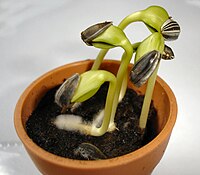
Photo from wikipedia
Seed germination is critical to the life history of plants, playing an important role in the successful recruitment, colonization, and even invasion of new individuals within and outside population distribution… Click to show full abstract
Seed germination is critical to the life history of plants, playing an important role in the successful recruitment, colonization, and even invasion of new individuals within and outside population distribution ranges. Cold stratification and temperature are the key factors affecting seed germination traits. Studying how these two factors drive geographical variation in seed germination is essential to analyze and predict the geographical distribution range of alien plants in novel habitats. Spartina alterniflora, native to the United States, was introduced into China in 1979 and has spread over 20° of latitude along the eastern coast of China. Germination plays a crucial role in S. alterniflora’s large-scale invasion and diffusion across latitude. To evaluate the effects of cold stratification and temperature on seed germination of S. alterniflora across latitude, we collected seeds at seven locations across latitude in China. We exposed these provenances to cold stratification at 4°C (0, 1, 3, and 5 months) and germination temperature (5°C, 15°C, 25°C, and 35°C) treatments in growth chambers. Seed germination was observed for 98 days, and we calculated germination rate, germination index, and germination time. Results indicated that longer cold stratification significantly promoted germination rate and germination index, but decreased germination time. Similarly, higher germination temperature significantly promoted germination rate and germination index, but decreased germination time. Moreover, there were significant interactive effects on germination traits between cold stratification and temperature. Seed germination traits showed linear relationships with latitude, indicating that S. alterniflora seeds from different provenances germinated at different times and adopted different germination strategies. The stratification and temperature are the most important factors regulating the dormancy and germination seeds, so they can be important drivers of this variation along latitude. Under scenarios of warmer regional temperature, seeds at higher latitudes could germinate earlier and have higher germination rate, which would favor a potential northern expansion of this invasive plant.
Journal Title: Frontiers in Plant Science
Year Published: 2022
Link to full text (if available)
Share on Social Media: Sign Up to like & get
recommendations!